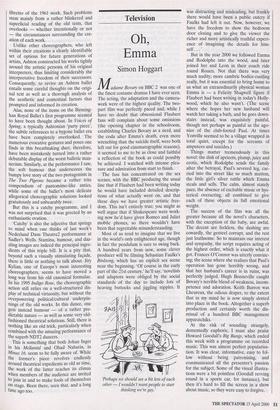Dance
Ashton Programme (Birmingham Royal Ballet) Triple Bill (Nederland Dans Theatre2, Sadler's Wells)
Think again
thannandrea Poesio
To revive ballets that have long been out of sight but are still fondly remembered is a tricky business, as the first of the two Birm- ingham Royal Ballet's programmes devot- ed to some rarely performed Ashton works proved last week. Despite the technical brilliance of the company's dancers and their enthusiastic approach to the choreog- raphy, the performance lacked both the sparkling theatricality and the sustained lyricism that were once associated with the 1961 ballet, The Two Pigeons, and the shorter pieces (Voices of Spring, Tweedle- dum and Tweedledee, Five Brahms Waltzes in the Manner of Isadora Duncan and The Walk to the Paradise Garden) with which the evening kicked off.
What I saw instead was an excessively affected rendition of the distinct stylistic features of each of the four 'diverts' — as they are more or less incorrectly referred to — and an equally over-the-top dramatic reading of the originally pastel-toned libretto of the 1961 work. Such problems stem mainly from a rather blinkered and superficial reading of the old texts, that overlooks — whether intentionally or not — the circumstances surrounding the cre- ation of each work.
Unlike other choreographers, who left within their creations a clearly identifiable set of options for future generations of artists, Ashton constructed his works tightly around the artistic persona of his original interpreters, thus limiting considerably the interpretative freedom of their successors. Consequently, to revive an Ashton ballet entails some careful thoughts on the origi- nal text as well as a thorough analysis of the aesthetic and contextual factors that prompted and informed its creation.
Alas, none of the items on the Binning- han Royal Ballet's first programme seemed to have been thought about. In Voices of Spring, a typically Ashtonian 'party piece', the subtle references to a bygone ballet era have been completely overlooked. The numerous evocative gestures and poses one finds in this breathtaking duet, therefore, have been mistakenly turned into a rather debatable display of the worst balletic man- nerism. Similarly, at the performance I saw, the soft humour that underscores the bumpy love story of the two protagonists in The Two Pigeons became a rather trite compendium of pantomime-like antics, while some of the ballet's most delicate allegorical choreographic solutions looked gratuitously and unbearably twee.
But this is a catchy programme, and I was not surprised that it was greeted by an enthusiastic ovation.
'Catchy' is also the adjective that springs to mind when one thinks of last week's Nederland Dans Theatre2 performance at Sadler's Wells. Stamina, humour, and daz- zling images are indeed the principal ingre- dients of this triple bill. It is a pity that, beyond such a visually stimulating façade, there is little or nothing to talk about. Jiry Kylian, one of Europe's most interesting choreographers, seems to have moved a long way from his old canonical formulae. In his 1995 Indigo Rose, the choreographic action still relies on a well-structured dis- play of technical virtuosity, but without the overpowering political/cultural underpin- nings of the old works. In this dance, one gets instead humour — of a rather pre- dictable nature — as well as some very old- fashioned theatrical solutions. Still, there is nothing like an old trick, particularly when combined with the amazing performance of the superb NDT2 dancers. This is something that both Johan Inger in his Mellantid and Ohad Naharin, in Minus 16, seem to be fully aware of. While the former's piece revolves endlessly around theatrical expedients as old as time, the work of the latter reaches its climax When members of the audience are invited to join in and to make fools of themselves On stage. Been there, seen that, and a long time ago too.



































































 Previous page
Previous page